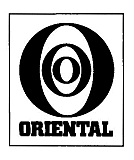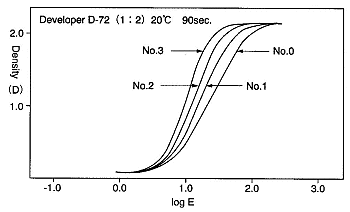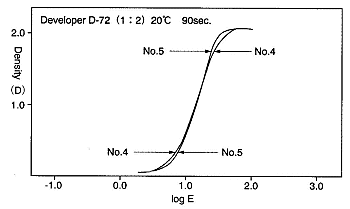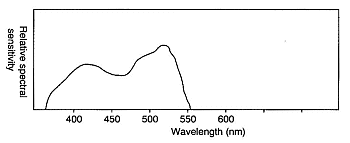 NEW SEAGULL SELECT VC-RP
NEW SEAGULL SELECT VC-RP
RP Paper
New Seagull Select VC-RP
By using filters, it is possible to control the tones of the finished
New Seagull Select VC-RP prints with this variable-contrast paper. With
one type of paper, it is possible to handle a broad range of tones (#0~#5).
New Seagull Select VC-RP is protected top and bottom by thin polyethylene,
processing agents do not penetrate into the paper and wash times are dramatically
shortened, making it a high-efficiency product. Also fast drying and excellent
flatness make it suitable as general-purpose printing paper.
Safelights
15W bulbs should be used and Kodak OC or a Ilford 5902 Safelight filter
are recommended. The safelight should be at least 1 .2 meter from the bed
of the enlarger or developer. After exposure, be careful not to expose
the emulsion side of the print to light.
Light source
In the case of VC-RP, a tungsten or halogen light source can be used.
VC-RP is designed to be usable with a dichroic color head. A magenta light
source produces a high contrast and a yellow light source produces low
contrast. When using your own dichroic color head, do some testing before
making a final decision on level of contrast. (Table 1 )
Exposure
Correct exposure times depend on the type of the light source of an
enlarger and the characteristics of the negatives being printed. To get
good final prints, test prints at various exposure levels should be made
first.
Exposure times depend on the type of filter being used. For filters
ranging from #0 to 3 1/2, prints can be made at almost the same exposure
times. For #4~#5 filters, exposure times should be 1 .5 times that
used for the other filters. When using a cool light head, adjustment must
be made for the light source and the photographic paper by using adding
a Kodak CC Filter-40Y.
Sensitivity and gradient
| ISO Speed |
ISO Range |
| P125 - 400 |
R50 - 120 |
Standard processing conditions
| Process |
Processing temperature |
Processing time |
| Development |
20+_ 0.5 C |
60~90 sec. |
| Stop bath |
15~25 C |
5~15 sec. |
| Fixing |
15~25 C |
3~5 min. |
| Washing |
15~25 C |
5~10 min. |
| Drying |
60~70C |
30~60 sec. |
Developer
For VC-RP printing paper, it is possible to use almost all commercially
available developing solutions (D-72, etc.). The developing conditions
depend on the chemicals and dilution level of the developer. Care should
be taken to avoid over-developing which raises the fog and lowers contrast.
VC-RP is applicable to both dish development and automatic development
using an auto processor.
Stop bath
For the stop bath, a solution of 1 .5% of glacial acetic acid is used.
Time: 15 to 30 seconds.
| Water |
1 liter |
| Glacial acetic acid |
15 ml |
Fixer
Prepared fixer is recommended but, if you are preparing your own fixer,
either use an acid hardening fixer containing sodium thiosulfate (hypo)
or a rapid fixer containing ammonium thiosulfate. To make sure the prints
will develop uniformly and not be affected by contaminants in the developer,
the prints should be shaken in the developer. Keep the total fixing time
to ten minutes or less. If the fixing time is too long, there is a risk
that the tone balance will degrade.
Washing
The washing process can be finished in about five minutes by washing
in water while stirring. The stirring should not be to strong since the
corners of the prints may be damaged. If the washing is continued for too
long a time, the surface of the prints may become rough.
Types of paper
| Type |
Base paper |
Weight |
Texture |
Tint |
Image tone |
| PR-F |
RP paper |
Medium |
Glossy, smooth |
White |
Jet black |
Drying
Drying is carried out using a hair dryer. It is also possible to dry
the prints naturally if they can be placed in a location where there is
sufficient air circulation.
High-temperature processing conditions New Seagull VC-RP has the properties
which make it well-suited for high-speed processing.
Storage and treatment
Always store photographic paper in a cool, dry place. It is also effective
to put a desiccant in a package which has been opened to keep the paper
dry.
The paper should be used quickly after the package has been opened.
Be careful to avoid exposing the paper for long periods to a safelight,
or letting the emulsion side come into contact with fingers.
(Table 1)Comparison of filters and light sources
Oriental
VC Filter |
Ilford Multiple
Grade Filter |
Kodak CC Filter |
Durst Omega
D5500 Color Head |
| 0 |
0 |
80Y |
110Y |
| 1 /2 |
1 /2 |
55Y |
90Y |
| 1 |
1 |
30Y |
70Y |
| 1 1 /2 |
1 1 /2 |
15Y |
30Y |
| 2 |
2 |
0 |
0 |
| 2 1/2 |
2 1/2 |
25M |
30M |
| 3 |
3 |
40M |
45M |
| 3 1/2 |
3 1/2 |
65M |
55M |
| 4 |
4 |
100M |
95M |
| 4 1/2 |
4 1/2 |
150M |
130M |
| 5 |
5 |
200M |
170M |
Use 47B to obtain maximum contrast
Characteristics curve
 |
 |
Spectral sensitivity
 |
|





